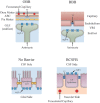Fluid Dynamics Inside the Brain Barrier: Current Concept of Interstitial Flow, Glymphatic Flow, and Cerebrospinal Fluid Circulation in the Brain
- PMID: 29799313
- PMCID: PMC6416706
- DOI: 10.1177/1073858418775027
Fluid Dynamics Inside the Brain Barrier: Current Concept of Interstitial Flow, Glymphatic Flow, and Cerebrospinal Fluid Circulation in the Brain
Abstract
The discovery of the water specific channel, aquaporin, and abundant expression of its isoform, aquaporin-4 (AQP-4), on astrocyte endfeet brought about significant advancements in the understanding of brain fluid dynamics. The brain is protected by barriers preventing free access of systemic fluid. The same barrier system, however, also isolates brain interstitial fluid from the hydro-dynamic effect of the systemic circulation. The systolic force of the heart, an essential factor for proper systemic interstitial fluid circulation, cannot be propagated to the interstitial fluid compartment of the brain. Without a proper alternative mechanism, brain interstitial fluid would stay stagnant. Water influx into the peri-capillary Virchow-Robin space (VRS) through the astrocyte AQP-4 system compensates for this hydrodynamic shortage essential for interstitial flow, introducing the condition virtually identical to systemic circulation, which by virtue of its fenestrated capillaries creates appropriate interstitial fluid motion. Interstitial flow in peri-arterial VRS constitutes an essential part of the clearance system for β-amyloid, whereas interstitial flow in peri-venous VRS creates bulk interstitial fluid flow, which, together with the choroid plexus, creates the necessary ventricular cerebrospinal fluid (CSF) volume for proper CSF circulation.
Keywords: AQP-4; Virchow-Robin space; aquaporin; choroid plexus; tight junction.
Conflict of interest statement
Figures







References
-
- Abbott NJ. 2004. Evidence for bulk flow of brain interstitial fluid: significance for physiology and pathology. Neurochem Int 45:545–52. - PubMed
-
- Badaut J, Brunet JF, Grollimund L, Hamou MF, Magistretti PJ, Villemure JG, and others. 2003. Aquaporin 1 and aquaporin 4 expression in human brain after subarachnoid hemorrhage and in peritumoral tissue. Acta Neurochir 86:495–8. - PubMed
-
- Benga G, Popescu O, Borza V, Pop VI, Muresan A, Mocsy I, and others. 1986. Water permeability of human erythrocytes. Identification of membrane proteins involved in water transport. Eur J Cell Biol 41:252–62. - PubMed
Publication types
MeSH terms
Substances
LinkOut - more resources
Full Text Sources
Other Literature Sources

